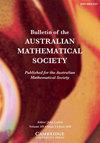THE SUMMED PAPERFOLDING SEQUENCE
IF 0.6
4区 数学
Q3 MATHEMATICS
引用次数: 0
Abstract
The sequence汇总折纸序列
序列 $a( 1) ,a( 2) ,a( 3) ,\ldots, $ 在《整数序列在线百科全书》中标为 A088431, 其定义如下: $a( n) $ 是 $$ \begin{align*} 的续分数展开式中 $( n+1) $ 第三项分量的一半,即 $( n+2) $ 第三项。\sum_{k=0}^{\infty }\frac{1}{2^{2^{k}}}.\end{align*}$$ Dimitri Hendriks 认为它是折纸序列 A014577 的运行长度序列。本文证明了这个求和折纸序列的几个结果,并证实了亨德里克斯的猜想。
本文章由计算机程序翻译,如有差异,请以英文原文为准。
求助全文
约1分钟内获得全文
求助全文
来源期刊
CiteScore
1.20
自引率
14.30%
发文量
149
审稿时长
4-8 weeks
期刊介绍:
Bulletin of the Australian Mathematical Society aims at quick publication of original research in all branches of mathematics. Papers are accepted only after peer review but editorial decisions on acceptance or otherwise are taken quickly, normally within a month of receipt of the paper. The Bulletin concentrates on presenting new and interesting results in a clear and attractive way.
Published Bi-monthly
Published for the Australian Mathematical Society

 求助内容:
求助内容: 应助结果提醒方式:
应助结果提醒方式:


